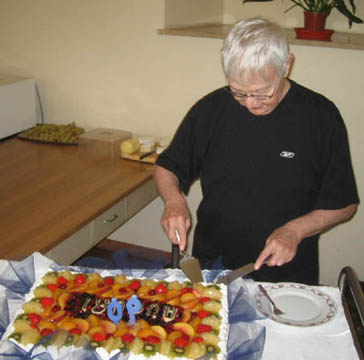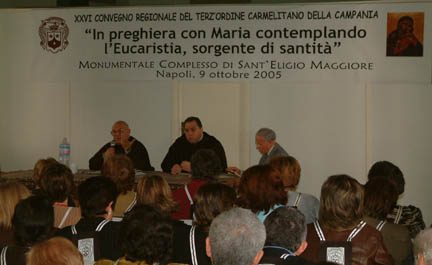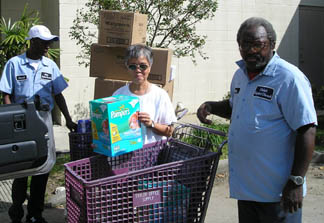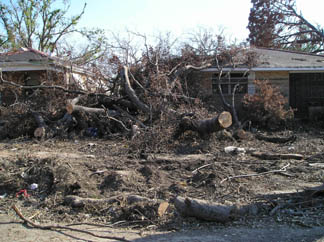|
no. 4 october - december 2005
Teacher, Historian, Writer, Community Man On October 9, Joachim Smet quietly celebrated his 90th birthday with community and friends at CISA in Rome—the place that has been his home for almost six decades. "Quietly" is the word that describes how much of Joachim’s life has been lived. Other than serving one six year term as an Assistant General, he has quietly labored, officially since 1947, to research and write the most comprehensive history of the Carmelite Order that exists. It has been a labor done without much fanfare. He attributes his vocation to the Carmelites to none other than St. Thérèse of Lisieux. Joachim made his first communion on May 17, 1925, the day Thérèse was canonized. Later he took the scholarship test for the Carmelite Minor Seminary in Niagara Falls, Canada and was notified on May 17th that he had won the scholarship. In those years of the economic depression in the USA, a scholarship was the only way his parents could afford to send him to a Catholic school. Asked to identify his favorite character in Carmelite history, he says "I don’t have any actually." When asked to identify a Carmelite in history that he feels has not received his deserved recognition he says, "Practically no Carmelite got a big play—they were all passed over." But Joachim had brushes with one of the most famous Carmelites of our time, Titus Brandsma. On a speaking tour of the two American Provinces in 1935, Brandsma was present for Joachim’s first profession in the Carmelite chapel at Niagara Falls. Joachim’s mother, a Belgian, spent some of her visit to Niagara Falls for her son’s profession walking around the drive in front of the college speaking with Brandsma in Flemish.
Joachim’s lifelong project started deliberately enough. "I had made up my mind when I was in theology in Niagara that I would write a history of the Order. In the novitiate I read the Analecta. But it was at the General Chapter of 1947 that the project became legitimate. "Someone stood up and said ‘Hey, we should get a history of the Order’ and Matt O’Neill (then Prior Provincial of the PCM Province) said ‘I have just the guy to do it.’ I was the 5th wheel on the wagon in New Baltimore at the time. I was told I would be going to Rome. It was the time of transition in the Italian government and Matt O’Neill said ‘If the Communists win, you are staying home. I arrived in Rome the last few days of April that year." He is still there 57 years later, working each day. Always an active man, Joachim underwent a triple by-pass surgery on July 31, 2003. "I will never forget that day. It took all the starch out of me. I have never recovered my energy. I can’t walk like I used to and I sleep a lot." Then, after a short pause, he adds with a little chuckle, "Of course, I am 90 years old and need to face that fact one of these days." For Joachim, history is a tool for critiquing the present. "The problems the Order has today are nothing like we have had in the past. At one point, in the 1880’s or so, there were about 200 people in the whole Order." He says he would have preferred to live in the 19th century. "It was the Industrial Revolution and the working people did not have it easy. Yet life was simpler. Life was quieter. Life was a lot more peaceful. Now we keep getting told what we need, what we absolutely must have. Quite frankly we are the most comfortable generation but all of our comforts make noise! We have had wonderful inventions in my lifetime but how many have been used to ruin the world. It has not been a very good century in a lot of ways. Before the interview is complete, Joachim returns to the question of his favorite Carmelite in history. He gives the nod to Cyril Knoll, the 19th century German Carmelite who left the monastery in Straubing to bring Carmel to the United States. "Knoll had all sorts of faults. He paid attention to nobody. He took in anyone to be a Carmelite as long as he was breathing. But when he retired to Scipio, Kansas for the last 20 years of his life, no one heard from him. And yet he really was responsible for building the (PCM) Province." There is a little of the retired Cyril Knoll in Joachim. Over the years, he was tucked away in CISA, working away quietly. Many Carmelites have never met him although they might recognize his name from some lecture during novitiate. Yet he is responsible for one of the great contributions to the Order in the 20th century. Ad multos annos! 1) Joachim Smet moves in to cut his birthday cake as members of the community, the Curia, and friends from the Rome area came together to help him celebrate. He has quite a bit of experience cutting birthday cakes—this was his 90th cak e. (CITOC photo)2) The signatures from the profession statement includes that of Blessed Titus Brandsma who was visiting the Carmelite college in Niagara Falls at the time.
The XII meeting of the Carmelite Family of the Iberian Region (Spain and Portugal) took place June 27-30, 2004 in El Carmen de Onda (Castellón), Spain. The meeting is prepared each year by either a province or a congregation of the sisters in the region. The Arago-Valentine Province was responsible for the 2005 meeting. Some 100 male and female religious and lay Carmelites took part. Also present were the Priors Provincial: David Oliver Felipo (Arago-Valentine Province and in charge of the meeting), José Ramírez Román (Baet), Luís Ortiz Serrano (Cast), and Raúl Masana i Peiró (Cat). Also present were two of the Superioras Generales: Sr. Encarnación Flórez González (Carmelitas del Sagrado Corazón), Sr. Maria del Carmen Aparicio Personal (Hermanas de la Virgen Maria del Monte Carmelo) and a group of Portugese religious in the name of the General Commissariat of Portugal. The theme of the meeting was To Live in Faith in Communion with Jesus, focusing on the idea of Klemens Stock, SJ, exegete of the New Testament at the Pontifical Institute Biblicum in Rome and General Secretary of the Pontifical Biblical Commission. This theme was developed in very interesting ways. Salvador Villota Herrero led the debates with great skill. The Novitiate Directors and the novices were responsible for the liturgies and the Lectio Divina.
On October 9, 2005 the XXVI Regional Meeting of the Carmelite Third Order of the General Commissariat of La Bruna met in Naples. Approximately 300 Third Order members from the region of Campania (the area around Naples) attended. The theme of the meeting was "In Prayer with Mary, Contemplating the Eucharist Well of Holiness" and was explained by Carlo Cicconetti, the Vice General of the Order. The Regional President greeted the participants. There was time to exchange ideas. The meeting began at 9 AM with the first session being held in the room of the Hermanas Angélicas of the mamouth complex of San Egidio in Naples. Following lunch, everyone went in procession to the nearby Basilica of Carmen Maggiore for the celebration of the Eucharist, presided by Carlo Cicconetti and assisted by Alfredo di Cerbo, the Commissary General, and by Francesco Sorrentino, the delegate for the Lay Carmelites of the General Commissariat. Carmelites Are Refugees in Southern USA Following Two Hurricanes Two Category 5 hurricanes struck the southern part of the United States of America within one month. On August 29, 2005 Hurricane Katrina created severe damage in a 90,000 square mile area around the city of New Orleans, Louisiana. The Congregation of Our Lady of Mount Carmel is headquartered in this area and most of the sisters live and work there. Hurricane Rita struck a few weeks later, affecting the Houston, Texas area where the Carmelites have two parishes and a house for initial formation. Some of the sisters had moved to Houston from the New Orleans area seeking shelter from the aftermath of Katrina.
"Katrina and Rita did not care if you were rich or poor, black or white, young or old; they destroyed everything in their paths," said Jane Remson, a member of the Congregation. An initial report clarified that all of the sisters were safe but 39 had to be relocated around Louisiana and Texas. The General Curia and the Spirituality Center in Lacombe were able to accommodate some of the sisters. The elderly sisters who would have been at the motherhouse in the city of New Orleans had been evacuated in advance and are safe in Lafayette, Louisiana and the infirmed are in Welsh, Louisiana. The damage to the sisters’ properties in the New Orleans area was extensive. The motherhouse and Mount Carmel Academy were flooded by 13 feet of water. Both buildings are near the 17 th Street Canal. Cleanup has begun on both buildings however.
Sr. Camille Anne Campbell, the Academy’s principal, reminds visitors to the website that "Our convent and school were the first major buildings and institutions in what is now Lakeview. The community grew around us. We will once again be a beacon of hope to our neighbors and they will rebuild around us. God is with us." The formation house was reported to be in 11 feet of water at one point. The formation library was destroyed. All the belongings of the sisters who live there were lost. The Carmelites were left watching television and internet reports on the disaster, trying to catch news of their homes, ministries, or even section of town in the various reports. On September 26, Hurricane Rita made landfall in the southwest corner of Louisiana. While Houston had braced for the worst, minor damage to buildings and trees was sustained. The formation house lost utilities for four days. However, several of the levees in New Orleans sustained further damage and additional flooding was reported as a result of Rita. 1) Sr. Blaise of the Congregation of Our Lady of Mount Carmel, herself a victim of hurricane Katrina, assists others in loading supplies into a car which will be taken to a family with small children. (Photo courtesy of the Congregration of OLMC)2) Homes in New Orleans’ Lakeview area, near the motherhouse and the Academy of the sisters of the Congregation of Our Lady of Mount Carmel. (Photo courtesy of the Congregration of OLMC) Eyewitness Account – The Recovery from the Hurricanes Hurricanes Katrina and Rita left a path of death and destruction 90,000 square miles in their wakes. Katrina and Rita did not care if you were rich or poor, black or white, young or old; they destroyed everything in their paths. The images one sees on TV or in the newspapers and magazines do not adequately convey the reality of the situation. What is missing from the pictures are the smells left behind by the receding flood waters. The gross incompetence of the Bush administration in responding to the disaster was far overshadowed by acts of kindness and heroism by hundreds of thousands of people helping one another. So many people lost so much; family members, houses, businesses, schools and churches. Entire neighborhoods of New Orleans are no longer there - they have been wiped away by wind and water. There are as many stories to tell as there are people. Our Motherhouse and the adjacent high school were flooded by 13 feet of water. The convent where I live lost its roof and the contents ruined. We survived, hopefully as better people because of our common experience. Sisters Blaise, Helen, Mary Ellen and I evacuated 135 miles northwest of New Orleans. From this safe distance we watched Katrina on TV destroy our city. We stayed several days then departed for different areas. Helen traveled to New York for the annual NGO/DPI conference at the United Nations; Mary Ellen traveled to Lafayette to help take care of the elderly, and Blaise and I went to Cocodrie, a fishing village in costal Louisiana. Each day Blaise and I commuted 50 miles to New Orleans to work with Chef Relief. Chef Relief is made-up of corporate chefs from all across the USA. They prepared hot meals for the police, soldiers, health workers, and people in shelters, especially those living in church shelters. We felt fortunate to be part of this project, which fed thousands of people. It will take time for New Orleans to rebuild, but rebuild it will! Jane Remson, O. Carm.
|
|||||||||
|
RETURN TO THE INDEX FOR 2005 | RETURN TO THE INDEX FOR THIS ISSUE INDEX OF CARMELITE
WEBSITES |


 Titus Brandsma is one of only five Carmelites who signed Joachim’s
profession paper. Joachim will gladly show you the paper if you give him a
little time to dig it out of the shelves that line one entire wall of his
room. "I should really probably get the thing framed," he says of his
profession paper.
Titus Brandsma is one of only five Carmelites who signed Joachim’s
profession paper. Joachim will gladly show you the paper if you give him a
little time to dig it out of the shelves that line one entire wall of his
room. "I should really probably get the thing framed," he says of his
profession paper.

 The Category 5 rating on the Saffir-Simpson Hurricane Scale means the
storm has winds greater than 155 mph (135 kt or 249 km/hr) and storm surge
generally greater than 18 ft above normal. Complete roof failure on
residences and industrial buildings is expected. The collapse of buildings
is also common. Prior to Hurricanes Katrina and Rita, only three Category
5 hurricanes have made landfall in the United States of America since the
records began.
The Category 5 rating on the Saffir-Simpson Hurricane Scale means the
storm has winds greater than 155 mph (135 kt or 249 km/hr) and storm surge
generally greater than 18 ft above normal. Complete roof failure on
residences and industrial buildings is expected. The collapse of buildings
is also common. Prior to Hurricanes Katrina and Rita, only three Category
5 hurricanes have made landfall in the United States of America since the
records began. According to postings on the Academy’s website, over 100 workers are in
the school cleaning and removing debris. The workers are living in tents
on the property to avoid the loss of time and expense traveling. They also
provide some security for the buildings. None of the buildings have
structural damage.
According to postings on the Academy’s website, over 100 workers are in
the school cleaning and removing debris. The workers are living in tents
on the property to avoid the loss of time and expense traveling. They also
provide some security for the buildings. None of the buildings have
structural damage.